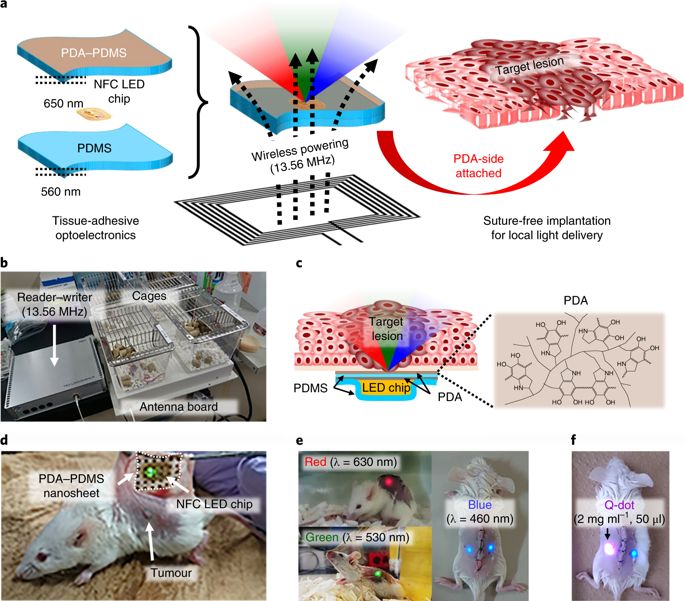メトロノミック光線力学的がん治療に向けた組織接着性・無線給電式発光デバイス
Tissue-adhesive wirelessly powered optoelectronic device for metronomic photodynamic cancer therapy
2018年7月16日 Nature Biomedical Engineering 3 : 7 doi: 10.1038/s41551-018-0261-7

生体内の病巣を治療するメトロノミック(すなわち、低強度で長期間の)光線力学療法(mPDT)では、生体内の組織表面に発光デバイスを確実に固定し、光が局所的に連続照射されるようにすることが必要である。縫合術はデバイスを固定するための標準的な選択肢であるが、周囲に重要な神経や血管が存在する場合のほか、臓器や組織が脆弱であったり、形状を変化させたり、活発に動いたりする場合には適さないことがある。今回我々は、近距離無線通信発光式LEDチップおよび生体接着性と伸縮性を有するポリドーパミン修飾ポリジメチルシロキサンナノ薄膜によって構成される無線給電式・埋め込み型のmPDTデバイスを動物体内の組織表面上に安定的に固定できることを示す。皮内に腫瘍を移植したマウスの皮下にこのデバイスを埋め込んだところ、従来のPDT法の約1,000分の1の光強度による10日間の照射で有意な抗腫瘍効果が得られた。このmPDTデバイスは、検出が困難な微小腫瘍および標準的な光線療法による照射が困難な深部に位置する病巣の治療戦略に有用となる可能性がある。
Corresponding Author
Metronomic (that is, low-dose and long-term) photodynamic therapy (mPDT) for treating internal lesions requires the stable fixation of optical devices to internal tissue surfaces to enable continuous, local light delivery. Surgical suturing—the standard choice for device fixation—can be unsuitable in the presence of surrounding major nerves and blood vessels, as well as for organs or tissues that are fragile, change their shape or actively move. Here, we show that an implantable and wirelessly powered mPDT device consisting of near-field-communication-based light-emitting-diode chips and bioadhesive and stretchable polydopamine-modified poly(dimethylsiloxane) nanosheets can be stably fixed onto the inner surface of animal tissue. When implanted subcutaneously in mice with intradermally transplanted tumours, the device led to significant antitumour effects by irradiating for 10 d at approximately 1,000-fold lower intensity than conventional PDT approaches. The mPDT device might facilitate treatment strategies for hard-to-detect microtumours and deeply located lesions that are hard to reach with standard phototherapy.

